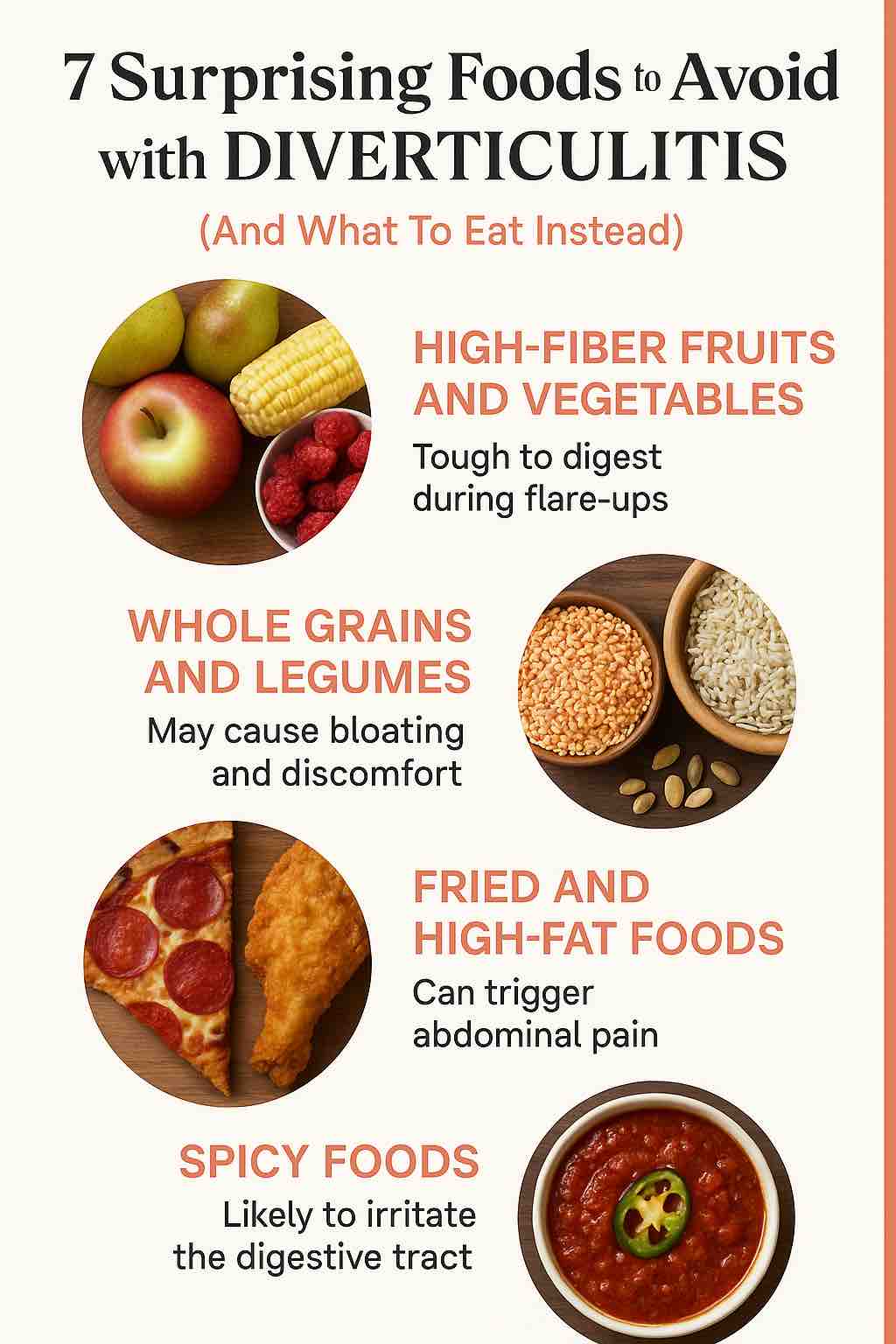
If you or a loved one has been diagnosed with diverticulitis, you know how painful and disruptive it can be. What you eat plays a huge role in managing this condition, especially during flare-ups. While there’s a lot of outdated advice floating around, recent research offers a more nuanced, science-backed approach to your diet. In this guide, we break down seven surprising foods you should avoid with diverticulitis and suggest safer, gut-friendly alternatives to keep you feeling your best.
What Is Diverticulitis? Diverticulitis occurs when small pouches (diverticula) in the lining of the colon become inflamed or infected. Symptoms can include abdominal pain, bloating, nausea, and changes in bowel habits. Diet is a critical part of both preventing flare-ups and recovering from them.
1. Beans and Legumes Why to Avoid: High in fiber and complex carbs, beans and legumes (like lentils, chickpeas, and black beans) can cause gas and bloating, worsening discomfort during a flare-up. Try Instead: Well-cooked carrots or peeled zucchini, which are gentler on the gut and easier to digest.
2. Whole Grains Why to Avoid: Brown rice, whole-wheat pasta, and quinoa may be healthy normally, but their high fiber content can be too rough on an inflamed colon. Try Instead: Opt for refined grains like white rice or sourdough bread during active flare-ups.
3. High-Fiber Fruits Why to Avoid: Apples with skin, raspberries, and citrus fruits can be too fibrous and acidic. Try Instead: Bananas, canned peaches (in water or juice, not syrup), or peeled and cooked apples.
4. Raw Vegetables Why to Avoid: While healthy in general, raw veggies like broccoli, kale, or bell peppers are hard to digest during flare-ups. Try Instead: Steamed or roasted root vegetables like carrots or peeled potatoes.
5. Nuts and Seeds The Twist: Contrary to old myths, recent research suggests they may not cause diverticulitis but can irritate some people during flare-ups. Try Instead: Nut butters (like almond or peanut) in small amounts or seedless smoothies.
6. Fried and Fatty Foods Why to Avoid: Pizza, fried chicken, and greasy burgers can slow digestion and trigger inflammation. Try Instead: Grilled chicken breast, steamed fish, or baked tofu.
7. Spicy Foods Why to Avoid: Spices like chili powder, cayenne, and hot sauce can irritate the digestive lining. Try Instead: Use fresh herbs like basil, parsley, or turmeric for flavor without the burn.
Other Foods to Watch Out For
- Red and processed meats: Linked to higher diverticulitis risk.
- Caffeinated and carbonated drinks: May increase bloating and pain.
- Alcohol: Can irritate the digestive system and worsen inflammation.
- Dairy: If you’re lactose intolerant, steer clear of milk and cheeses.
So, What Should You Eat? When you’re not in a flare-up, slowly introduce more fiber from:
- Cooked vegetables
- Peeled fruits
- Whole grains (start with oats or barley)
- Plenty of water to support fiber digestion
During flare-ups, switch to a low-fiber, bland diet to give your gut time to rest.
Final Thoughts: Trust Your Gut — Literally Every case of diverticulitis is unique. What bothers one person may be fine for another. Keep a food diary, listen to your body, and consult with a dietitian or gastroenterologist for a personalized plan.
By understanding the science behind your symptoms and making smarter food choices, you can better manage diverticulitis and live more comfortably.
Liked this post? Share it with someone who needs a gut-friendly guide!
10 FAQs About Diverticulitis and Diet
1. Can I ever eat fiber again if I have diverticulitis?
Yes, fiber is important for long-term gut health. During flare-ups, you should stick to a low-fiber diet. Once symptoms subside, gradually reintroduce fiber under medical guidance.
2. Are nuts and seeds safe with diverticulitis?
Despite old beliefs, recent research shows that nuts and seeds do not increase the risk of flare-ups. However, some individuals may still find them irritating during active inflammation.
3. What should I eat during a diverticulitis flare-up?
Stick to a low-fiber, bland diet: white rice, broth, cooked peeled vegetables, bananas, and applesauce. Avoid anything spicy, fatty, or high in fiber.
4. Is dairy okay with diverticulitis?
If you’re not lactose intolerant, small amounts of dairy may be fine. Otherwise, choose lactose-free alternatives or avoid dairy during flare-ups.
5. How long should I follow a low-fiber diet during a flare-up?
Typically for a few days to a week, or until symptoms improve. Then, fiber should be reintroduced gradually with professional guidance.
6. Can I drink coffee or soda with diverticulitis?
Caffeinated and carbonated beverages may cause bloating or discomfort. Limit or avoid them during flare-ups and monitor how your body reacts long term.
7. Are probiotics helpful for diverticulitis?
Some studies suggest that probiotics may help balance gut bacteria and reduce inflammation. Talk to your doctor about including them in your regimen.
8. How can I tell which foods trigger my symptoms?
Keep a food journal to track what you eat and how you feel. This can help identify personal triggers and guide dietary choices.
9. What foods can help prevent diverticulitis flare-ups?
After recovery, a high-fiber diet rich in cooked vegetables, whole grains, and fruits (with skins removed at first) can help prevent future issues.
10. Can I eat meat with diverticulitis?
Lean meats like chicken, turkey, or fish are generally safe. Avoid red and processed meats, which may increase the risk of inflammation and flare-ups.









